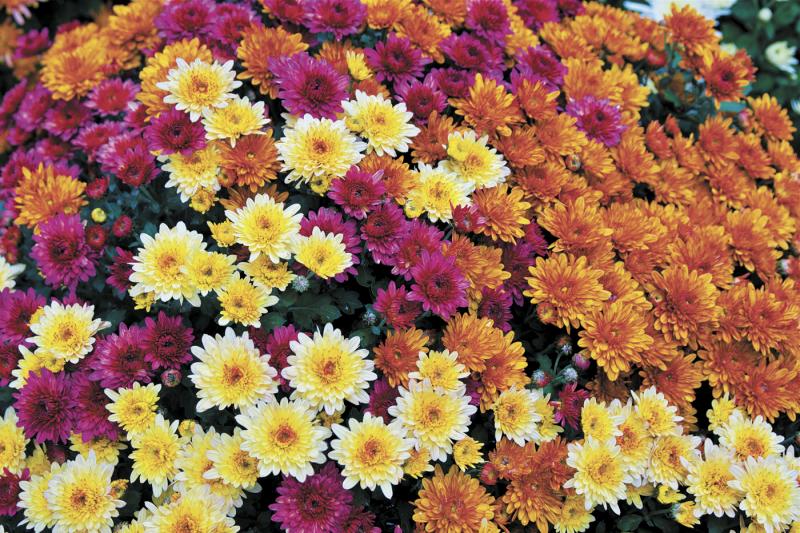Why do leaves change colors in the fall? Wyandot (Huron) legend tells of a fight between the Deer and the Bear in the land of the sky. Things would have gotten worse except the Wolf told them to stop fighting, and back then everyone obeyed the Wolf. The fleeing Deer dripped the Bear's blood from his horns, and that became the colors of the leaves every autumn.
Colored leaves and all, it's autumn and, “Mum's the word,” a phrase meaning keep quiet, used since Mr. Thomas Brown wrote it in 1720. Chrysanthemums, or mums, come in every color imaginable, from pastel pinks and yellows to dark browns and maroons. They grow best in full sun, in rich, well-drained soil. Mums make great container plants. For best results, plant mums in the spring, because fall-planted mums don't have time to grow deep roots before winter. That said, mums are readily available in full bloom every autumn, and can be planted directly in the garden. For longest bloom times, choose plants whose buds are only partly open. Apply a mulch after the ground freezes. Mums are hardy in USDA Zones 5-9.
Native plants not only tend to naturally do better, thanks to thousands of years of evolution, but also provide food sources for pollinators. The New England aster (Aster novae-angliae) blooms in the familiar dark purple, but also comes in shades of white, pink and lavender. The lanky plants reach 24 inches tall and spread up to 36 inches wide. New England asters are hardy in Zones 5-8 and naturalize easily.
A rather unusual fall-blooming perennial is the Japanese toad lily (Tricyrtis hirta) with blooms that look like small orchids. The 24- to 36-inch-tall plants start to bloom in late summer and continue right through early autumn. The one-inch flowers are stunning, with purple dots against either white or lavender background. Japanese honor their elders, and the Japanese toad lily gets better with age. Some older plants are completely smothered in blossoms. They naturalize easily, and often form colonies in partial to full shade in evenly moist soil. Don't let their delicate looks fool you; Japanese toad lilies are quite hardy and survive in USDA Zones 4-8.
For an airy, purple cloud of flowers, plant Russian sage (Perovskia atriplicifolia), and you will get blooms in summer followed by purple bracts that last until early winter. It resembles a large lavender plant. In autumn, the hairs on Russian sage stems give them a stunning silvery look. Russian sage isn't particular about soil, and does well in almost any type. A native of the steppes of Russia, the 36-inch-high Russian sage is very drought-tolerant. It grows best in full sun, and is striking when planted in front of yellow roses. Deer and rabbits tend to avoid eating Russian sage, and the plants even grow well in salty seaside conditions. The hardy plants grow in USDA Zones 4-9.
A fun flower for a kids’ garden is the Balloon Flower (Platycodon grandiflorus). It is called the balloon flower because the unopened flower buds look like tiny balloons. They are heavy bloomers with colors ranging from the popular lavender-blue to light pink and soft white. They grow best in full sun to light shade. You can grow them from seed. The slow-growing plants are not invasive, instead spreading slowly to form clusters. Balloon flowers are hardy enough to even grow in Alaska, doing well in USDA Zones 3-9.
Scarcity feeds our desires, and the autumn garden flowers are a welcome prelude to winter. Perhaps, like warm days in winter, the scarcer the flowers, the more precious they seem.




















































